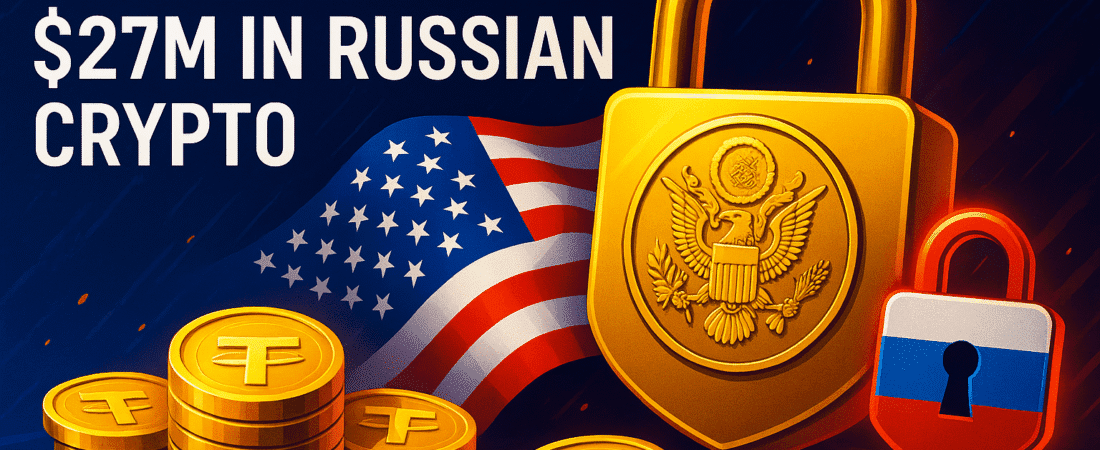U.S. Freezes $27M in Russian Crypto Assets as Sanctions Target Garantex, Grinex, and A7A5 Token
18 Aug



U.S. Freezes Russian Crypto: $27M Blocked in Escalating Sanctions
Executive Brief: Strategic Impact of U.S. Action on Russian Crypto Networks
- The U.S. Department of the Treasury has frozen $27 million in Russian-linked cryptocurrency assets as part of a sweeping escalation in sanctions against Russia’s digital financial infrastructure.
- This move targets the exchange platforms Garantex and successor Grinex, as well as the ruble-backed token A7A5, spotlighting their central role in Russia’s shadow crypto economy.
- The sanctions coincide with heightened global scrutiny of illicit crypto flows—particularly those used for ransomware operations, sanctions evasion, and state-backed financial innovation.
Strategic Context: Russia’s Crypto Infrastructure and Its Global Ramifications
- Over the past year, Russia has accelerated efforts to build alternative digital payment systems, strategically legalizing crypto mining and cross-border settlements to subvert Western controls.
- Garantex, established in Estonia in 2019, had its license revoked in 2022 due to anti-money laundering failures and links to criminal wallets. Undeterred, executives migrated user funds and operations to Grinex, enabling continuity despite international pressure.
- The ruble-pegged token A7A5, issued by Old Vector (supported by Russia’s state-owned Promsvyazbank), has processed over $51.1 billion in transactions, serving as a discreet but high-volume payment rail for sanctioned Russian enterprises—including suspected military procurement and commodity trade.
- According to blockchain analytics firm Chainalysis, this ‘shadow crypto economy’ provides ruble-to-crypto liquidity and is pivotal for business-to-business activity within Russia’s sanctioned networks.
- Key individuals driving these ecosystems include Aleksandr Mira Serda (Garantex co-founder and chief commercial officer), Sergey Mendeleev (Garantex co-founder), Pavel Karavatsky (Garantex co-owner), and Aleksej Besciokov (executive, Grinex/Garantex)—all now specifically targeted by U.S. authorities.
Sanction Details: Enforcement Tactics, Legal Precedents, and Targeted Entities
- The Office of Foreign Assets Control (OFAC) has re-designated Garantex and sanctioned Grinex alongside associated companies in Russia and Kyrgyzstan, such as Old Vector, InDeFi Bank, Exved, A7 LLC, A71 LLC, and A7 Agent LLC.
- Indictments were unsealed against Aleksandr Mira Serda and Aleksej Besciokov following a joint global law enforcement operation in March, leading to domain seizures, server confiscation, and the freezing of digital assets exceeding $26 million.
- The State Department has announced financial rewards of up to $6 million for actionable information leading to the arrest of Aleksandr Mira Serda. OFAC has added Sergey Mendeleev and Pavel Karavatsky to the sanctions list, intensifying pressure on executive leadership.
- The sanctioned exchanges have been directly linked to major ransomware groups, including Conti, LockBit, Black Basta, and Ryuk. The platforms provided infrastructure to conceal wallet ownership, enabling continued service to sanctioned Russian entities and facilitating hundreds of millions in illicit flows.
- Under Secretary of the Treasury for Terrorism and Financial Intelligence John Hurley has reiterated U.S. commitment to curbing cyber-enabled sanctions evasion, emphasizing “Digital assets play a crucial role in global innovation … the United States will not tolerate abuse of this industry to support cybercrime and sanctions evasion.”
Strategic Implications: Risks, Competitive Pressures, and Forward Guidance
- Garantex and Grinex are not only exposed to further asset seizures and legal risk, but will also face market trust erosion and loss of access to global exchanges—a critical threat to liquidity and expansion.
- The sanctions regime is evolving toward greater coordination and intelligence-sharing, with U.S., German, and Finnish authorities working cross-jurisdictionally, raising compliance barriers for international financial institutions inadvertently exposed to these networks.
- Russia’s ongoing development of legal frameworks for crypto mining and cross-border payments is likely to catalyze further innovation in sanctions evasion—potentially expanding A7A5 token access to retail markets through partnerships with national institutions such as Promsvyazbank.
- Blockchain’s transparency offers opportunities for ongoing disruption and monitoring, but also exposes actors to forensic scrutiny. Entities should expect regular de-anonymization of crypto transaction patterns linked to sanctioned individuals like Sergey Mendeleev and Pavel Karavatsky.
- For legitimate exchanges and institutional investors, reputational risk from association is increasing. Emerging compliance protocols may require continual review and adaptation to avoid inadvertent entanglement with sanctioned Russian entities.
Company Case Study: Garantex/Grinex Response and Strategic Adaptation
- Following enforcement actions, Garantex swiftly transferred its user base and digital assets to Grinex, demonstrating agility under regulatory pressure but also persistent vulnerabilities.
- Key leadership transitions—including the arrest of Aleksej Besciokov and targeting of Aleksandr Mira Serda—have not halted operational continuity, yet sustainability faces mounting international risk.
- A7A5’s network activity patterns (primarily business week operations) suggest ongoing strategic alignment with enterprise-grade partners, while recent site updates now advertise token purchases via PSB bank cards, potentially signaling a retail expansion.
- The evolving sanctions landscape suggests future asset freezes and further law enforcement scrutiny, necessitating proactive compliance, transparency, and adaptation from counterparties globally.
Regulatory Outlook: Future Enforcement and Strategic Recommendations
- The escalation of U.S. sanctions against Russian crypto infrastructure will accelerate global regulatory responses and force the reengineering of compliance systems across borderless digital finance firms.
- Exchanges, fintechs, and institutional investors should implement robust risk analytics, transaction monitoring, and continual due diligence for exposure to sanctioned entities such as Garantex, Grinex, Old Vector, and executives including Aleksandr Mira Serda and Sergey Mendeleev.
- Corporate strategists must anticipate the proliferation of new crypto-native payment rails and tokens designed to bypass sanctions. In particular, tokens like A7A5—representing over $51 billion in volume—should be categorized as high-risk for compliance protocols.
- The U.S. government’s reward and enforcement programs will likely spark additional whistleblower activity, threatening operational secrecy for Russian-linked entities and requiring dynamic adaptation from global partners.
Data-Driven Takeaway: Transactional Volume Defines Sanctions Evasion Scale
- The most significant figure is the cumulative transactional volume: A7A5 processed $51.1 billion through July 2025, underscoring both the sophistication and scale of Russia’s sanctions evasion strategy as orchestrated through Garantex, Grinex, and their executives.
- For corporate actors, vigilance against high-volume ruble-pegged tokens and exchange migration tactics should be codified in risk frameworks. The transactional thresholds observed with A7A5 and associated platforms set a new precedent for international enforcement priorities.
Leadership Messaging: Guidance from U.S. Treasury and Strategic Imperatives
- As stated by John Hurley, Under Secretary for Terrorism and Financial Intelligence, maintaining the integrity of virtual asset service providers and innovation in the sector demands aggressive, coordinated action against criminal abuses perpetuated by sanctioned Russian actors.
- For executives, the evolving sanctions environment is both a risk and an opportunity—necessitating enhanced compliance, adaptive strategy, and full transparency for any exposure linked to Garantex, Grinex, Aleksandr Mira Serda, and other sanctioned leaders.

コメントを書く